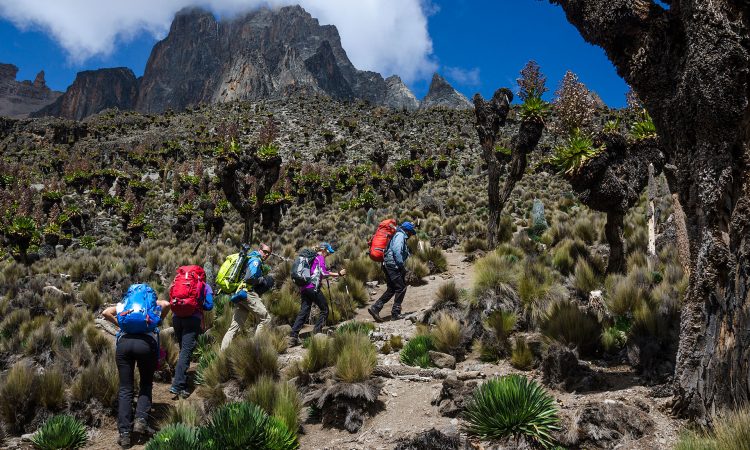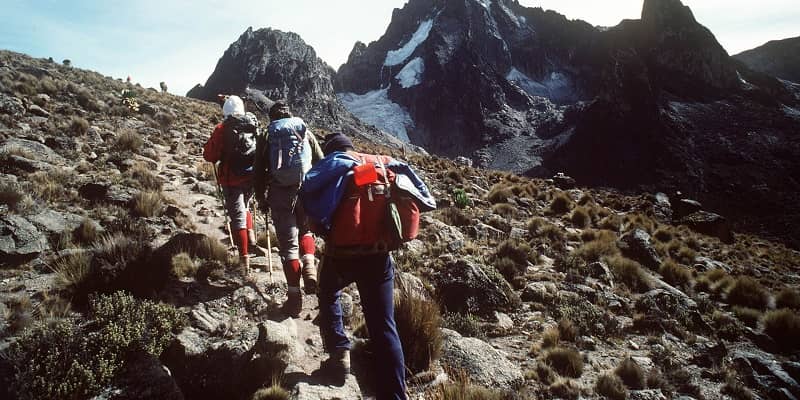Climbing Mount Kenya : A Great Alternative To Trekking Mount Kilimanjaro : With a peak elevation of roughly 5,199 meters above mean sea level, Mount Kenya is the second-highest peak mountain in Africa. In addition, it is a UNESCO World Heritage Site and the home of the legendary Kikuyu deity Ngai. The name Kirinyaga comes from the ancient Kikuyu people, who constructed their traditional homes facing this holy peak because they thought it was a place of light.

The mountain, which is a part of Mount Kenya National Park, is quickly reached by car or private plane. Three magnificent peaks on Mount Kenya—Nelion (5,188 meters above sea level), Lenana (4,985 meters), and Batian (5,199 meters)—offer different levels of difficulty for mountain climbers. These peaks also offer a variety of distinct environments and landscapes for wildlife and birds, creating distinct ecosystems that can differ greatly from one another.
Expect rocky terrain, African moors, and rain forests. The mountain displays a ragged array of snow-capped peaks that form freshwater pools at the bottom of the slopes. Dawn is the best time to see the mountain because the early morning light silhouettes its magnificent summit high above the plains and its surroundings.
Wildlife to enjoy in Mount Kenya National Park
The Mount Kenya National Park is where you’ll get to know Mount Kenya. Here, you can find lakes, glaciers, tarns, and unspoiled wilderness with a variety of geological phenomena. The Big Five (elephant, lion, cheetah, leopard, and rhino) as well as groups of baboons and monkeys, whose fascinating behavior is fascinating to watch, can also be found in Mount Kenya National Park.
Animals like waterbucks, tree hyrax, elands, and the white-tailed mongoose will also be visible. Birds will be plentiful; owls, eagles, nightjars, ibises, hawks, and sunbirds are prominent.
Getting there
You can travel to the mountain park in just two hours from Nairobi, the capital of Kenya, by taking the Nanyuki or Naro Moru routes. The cost of your safari itinerary includes transfers, with the option of a fly-in transfer even though the majority of travelers choose to travel by road. For the first leg of your trip, it is advised that you spend the night in Nairobi to fully experience the sights and sounds of this vibrant city.
CLIMBING MOUNT KENYA VS. MOUNT KILIMANJARO
Despite being the second-highest mountain in Africa, Mount Kenya’s ascent is by no means as taxing as climbing Mount Kilimanjaro. Technically speaking, the climb is less difficult than climbing Mount Kilimanjaro (which requires sophisticated equipment, training, and months of preparation), but it is still an interesting, slow ascent that can be completed at your own pace with some level of fitness. This task will be simple for you if you can walk steadily for six to eight hours per day.

It’s critical to keep in mind that altitude sickness, or “mountain sickness,” can affect climbers on Mount Kenya. Your professional guide will ensure that you drink plenty of water and climb gradually so that your body has time to get used to the higher altitude. It is advised that only novice mountaineers attempt to climb Lenana Point.
What about the weather?
From December to March, when Kenya experiences the most sunshine, is the ideal time to visit Mount Kenya. While drizzles begin in early October and last through early December, the rainy season lasts from March to June. Clear views are obstructed by cloudy and rainy periods. The weather will have an impact on your mountain climb, even though Mount Kenya National Park is open all year.
Remember that the mountain can experience temperatures below 20 °C (even on Lenana, which is lower in elevation than the other two peaks), and that the mornings and nights can be extremely chilly. However, Mount Kenya experiences plenty of daytime sunshine for the majority of the year, with the exception of the wet months.
Will I need to use a professional guide?
If you want to benefit from climbing Mount Kenya, it is strongly advised that you use the services of a reputable and experienced mountain climbing safari company such as Focus East Africa Tours. This is for your own safety as well as the enjoyment of seeing the scenery, animals, and birds through an enthusiastic and knowledgeable set of eyes. We can arrange everything for you, including finding out which mountain safari company has all the gear you need or if you have any special requirements.


